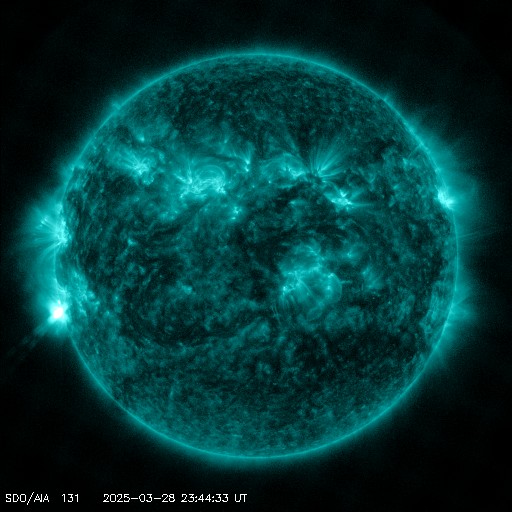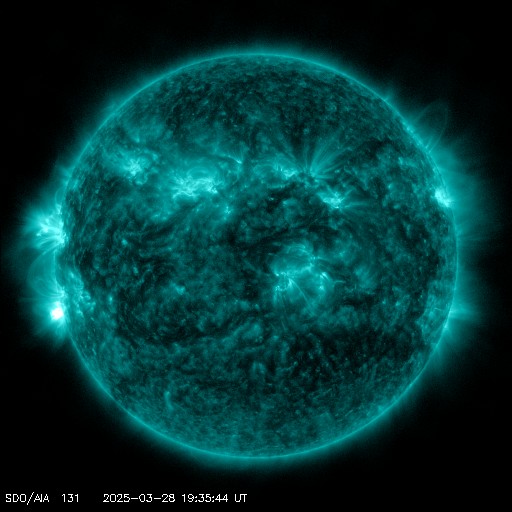Viewing archive of Sunday, 4 April 2010
Solar activity report
Any mentioned solar flare in this report has a scaling factor applied by the Space Weather Prediction Center (SWPC). Because of the SWPC scaling factor, solar flares are reported as 42% smaller than for the science quality data. The scaling factor has been removed from our archived solar flare data to reflect the true physical units.
Report of Solar-Geophysical Activity 2010 Apr 04 2201 UTCPrepared by the NOAA © SWPC and processed by SpaceWeatherLive.com
Joint USAF/NOAA Report of Solar and Geophysical Activity
SDF Number 094 Issued at 2200Z on 04 Apr 2010IA. Analysis of Solar Active Regions and Activity from 03-2100Z to 04-2100Z
Solar activity was very low. No flares were observed
during the past 24 hours. New Region 1060 (N24E58) was assigned
today and appears to be a small bipolar region.
IB. Solar Activity Forecast
Solar activity is expected to be very
low. However, there is a chance for an isolated C-class event during
the next three days (05-07 April).
IIA. Geophysical Activity Summary 03-2100Z to 04-2100Z
The geomagnetic field was mostly quiet to unsettled. However, there
was an isolated active period at mid-latitudes from 0600-0900Z which
was accompanied by storm level activity at some high latitude
stations. Solar wind speed observed by the ACE spacecraft were
elevated throughout the day, typically between 460-540 km/s. The
greater than 2 MeV electron flux at geosynchronous orbit reached
high levels during the past 24 hours.
IIB. Geophysical Activity Forecast
The geomagnetic field is
expected to be quiet with a chance for unsettled periods for the
first day (05 April) and partway through the second day (06 April).
An increase to mostly unsettled levels with a chance for active
periods is expected sometime late on the second day or early on the
third day (07 April) in response to a favorably positioned coronal
hole. Yesterdays halo CME appears to be primarily directed south of
the ecliptic plane. However, it is possible that the flank of the
CME could contribute to somewhat elevated activity on the third day.
III. Event Probabilities 05 Apr to 07 Apr
| Class M | 01% | 01% | 01% |
| Class X | 01% | 01% | 01% |
| Proton | 01% | 01% | 01% |
| PCAF | green | ||
IV. Penticton 10.7 cm Flux
Observed 04 Apr 079 Predicted 05 Apr-07 Apr 080/080/085 90 Day Mean 04 Apr 083
V. Geomagnetic A Indices
Observed Afr/Ap 03 Apr 005/008 Estimated Afr/Ap 04 Apr 010/010 Predicted Afr/Ap 05 Apr-07 Apr 005/007-007/010-012/012
VI. Geomagnetic Activity Probabilities 05 Apr to 07 Apr
| A. Middle Latitudes | |||
|---|---|---|---|
| Active | 05% | 25% | 35% |
| Minor storm | 01% | 10% | 20% |
| Major-severe storm | 01% | 01% | 05% |
| B. High Latitudes | |||
|---|---|---|---|
| Active | 10% | 30% | 40% |
| Minor storm | 05% | 15% | 30% |
| Major-severe storm | 01% | 01% | 10% |
All times in UTC
Current data suggests there is a slight possibility for aurora to appear at the following high latitude regions in the near future
NorilskLatest news
Latest forum messages
Incoming & Unnumbered Active Regions 1656AR4046 125Aurora photography hints for those of us with smartphones 48Large Coronal Hole 25 178LASCO Data Not Updating 5
More topicsSupport SpaceWeatherLive.com!
A lot of people come to SpaceWeatherLive to follow the Sun's activity or if there is aurora to be seen, but with more traffic comes higher server costs. Consider a donation if you enjoy SpaceWeatherLive so we can keep the website online!

Latest alerts
00:00 UTC - Solar flare
Moderate M1.79 flare
Friday, 28 March 2025
23:36 UTC - Radio Blackout
Minor R1 radio blackout in progress (≥M1 - current: M1.04)
21:24 UTC - Hemispheric Power Index
The OVATION model predicts the Hemispheric Power Index to reach 51GW at 21:59 UTC
19:45 UTC - Solar flare
Moderate M1.16 flare
19:27 UTC - Radio Blackout
Minor R1 radio blackout in progress (≥M1 - current: M1.1)
Space weather facts
| Last X-flare | 2025/03/28 | X1.1 |
| Last M-flare | 2025/03/28 | M1.7 |
| Last geomagnetic storm | 2025/03/27 | Kp5 (G1) |
| Spotless days | |
|---|---|
| Last spotless day | 2022/06/08 |
| Monthly mean Sunspot Number | |
|---|---|
| February 2025 | 154.6 +17.6 |
| March 2025 | 128.3 -26.4 |
| Last 30 days | 128.3 -23.7 |




